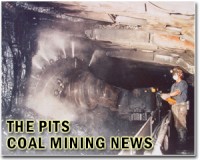 |
New York (AFP) Jan 5, 2011 Epic floods sweeping Australia could seriously limit the world's coal supplies, driving up prices and raising inflationary pressures throughout the global economy. The huge northeastern state of Queensland, now largely under water, provides half the world's needs for coking coal used in the steel-making industry. "It could take several weeks to reopen mines which have been physically flooded," said Ben Willacy, a Wood Mackenzie analyst based in Sydney. "Mines that have not been flooded will be dependent on the reopening of rail systems," he said. According to IHS Global Insight, the floods in Australia have led to the closure of an estimated 90 million tonnes of annual production capacity. Premium Peak Downs brand coking coal in Queensland was last quoted by the Commonwealth Bank of Australia at 253 US dollars a tonne. Six months ago the price barely scraped 200 dollars. "With disruption to supplies forecast to last until into early February 2011, competition for cargoes could increase on the spot market, pushing up prices further, particularly due to supply-security concerns," said Tom Grieder at IHS Global Insight. "The high prices for coking coal will probably be passed on by steel manufacturers, pushing up prices of steel and therefore construction costs for steel-intensive facilities such as oil refineries and petrochemical facilities." Barclays Capital analyst Amrita Sen said the coal market was already tight entering 2011. "Demand from Asia is already very strong, but with these weather problems, it has become significantly tighter," she said. Including steam coal exports, Australia is the largest of the world's five main coal exporters, the Barclays analyst added. Before the disastrous flooding in Queensland, major coal exporters Colombia and Indonesia also had been hit by heavy rains that affected production. And the derailment of a train in South Africa had blocked exports for several days at the end of last year. Sen pointed out that coking coal was not a very widely traded market because prices were set in contract negotiations. "As a result, the spot market is a very small percentage of the total," she said, compared with steam coal, used by power plants. "While spot coking coal prices are also up, given that steam coal is a bigger traded market, the price increases have been more visible." Unlike oil, metals or agricultural commodities, the coal market does not have a benchmark contract by which global trade can be measured. Analysts following steam coal look at the API-2 index of prices in the Dutch ports of Amsterdam and Rotterdam, and in Belgium's Antwerp. The steam coal market, considered one of the most active in the world, has seen prices rise from about 100 dollars a tonne in early December to 130 dollars. In the United States, the New York Mercantile Exchange launched a coal futures market in 2001 on steam coal mined in the Appalachian Mountains in the eastern part of the country. Although that market is considered fairly local, prices have jumped from under 75 dollars a tonne in December to more than 80 dollars Tuesday. "For a long time prices have been set by direct negotiations between the producer and the consumer," said Philippe Chalmain, economics professor at the Paris-Dauphine University in the French capital. "Today, especially for the steam coal market, it's beginning to become a market like the others."
Share This Article With Planet Earth
Related Links Powering The World in the 21st Century at Energy-Daily.com
 Rain, floods disrupt Queensland's coal
Rain, floods disrupt Queensland's coalBrisbane, Australia (UPI) Dec 30, 2010 Torrential rain and flooding have nearly brought the coal industry in the Australian state of Queensland to a standstill. Queensland, on the east coast of Australia, accounts for about two-thirds of the world's supply of coking coal, a vital ingredient in steel making. Its state capital, Brisbane, has recorded its wettest December in more than 150 years. The deluge of rain disrup ... read more |
|
| The content herein, unless otherwise known to be public domain, are Copyright 1995-2010 - SpaceDaily. AFP and UPI Wire Stories are copyright Agence France-Presse and United Press International. ESA Portal Reports are copyright European Space Agency. All NASA sourced material is public domain. Additional copyrights may apply in whole or part to other bona fide parties. Advertising does not imply endorsement,agreement or approval of any opinions, statements or information provided by SpaceDaily on any Web page published or hosted by SpaceDaily. Privacy Statement |